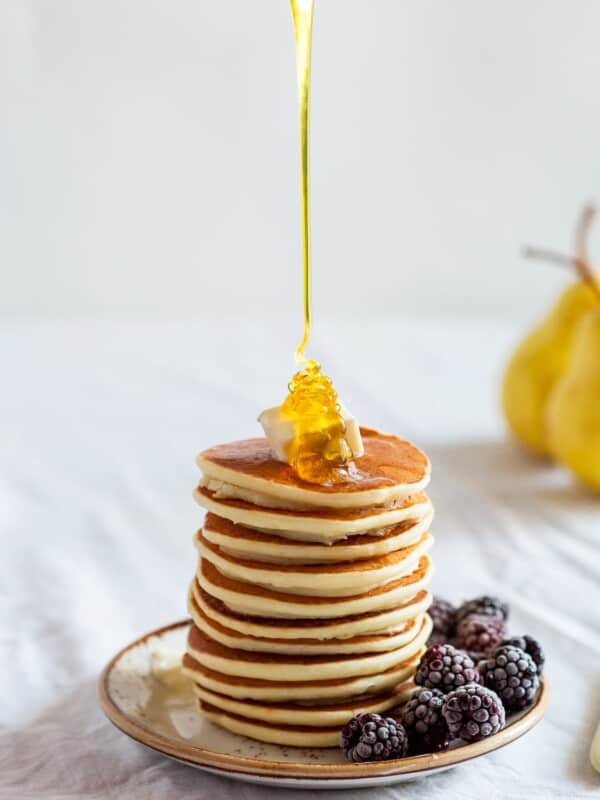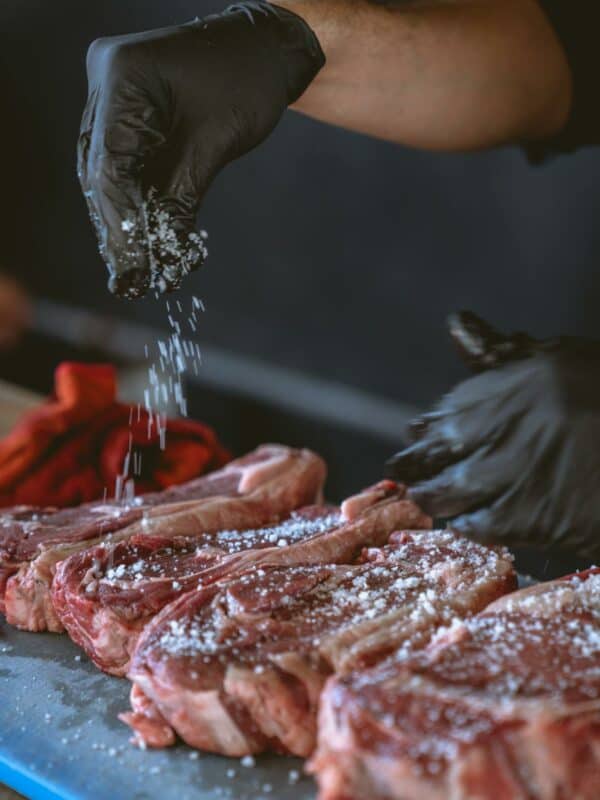Have you ever tried kung pao beef at your local Chinese restaurant? Well, the homemade kind is even better!
A fun twist on the Chinese classic kung pao chicken, this kung pao beef recipe is a sizzling stir fry sensation. Packed with flavor with a spicy, tangy sauce and lightning quick to make from start to finish, it’s sure to become a firm favorite in your household.

Why You Will Love This Kung Pao Beef Recipe
Incredible Flavors: This recipe is a blissful combination of peppery, hot, deliciously rich, sweet, and savory flavors.
Packed With Delicious Healthy Ingredients: This recipe is wonderfully tasty and good for you.
Quick And Easy To Make: You’ll be amazed at how simple and fast this kung pao recipe is.
Easy To Adapt: It’s a highly versatile recipe that can be adapted to suit your tastes and requirements. You can swap out beef for chickpeas to make a vegetarian kung pao dish or use seafood like this kung pao shrimp recipe.
Delicious Leftovers: It’s easy to store, and the dish comes together even better the next day, making leftovers a delight!

Ingredients
Beef Steak: Thinly sliced beef is the central ingredient in this recipe. Choose a cut of beef perfect for stir-fried recipes, like flank steak. Besides flank steak, you can use other cuts. See the FAQ section below for more guidance on choosing the ideal beef for kung pao.
Cornstarch: This helps to achieve the right texture for the dish.
Baking Soda: This helps to tenderize and flavor the meat.
Shaoxing Wine: An amber-colored rice wine with a deep, rich taste.
Avocado Oil: A flavorless oil like avocado oil is great for this recipe.
Oyster Sauce: Perfect for bringing an extra depth of flavor
Light Soy Sauce: It has a lighter flavor than its dark counterpart, but light is still important for this recipe.
Rice Vinegar: A typical Asian condiment.
Hoisin Sauce: A classic sauce made from fermented soybean paste, this sauce brings so much flavor to kung pao recipes.
Sichuan Peppercorns: Essential for bringing that wonderful, smoky, peppery heat to the dish.
Dark Soy Sauce: This ingredient is a staple in Asian cuisine.
Sesame Oil: A favorite oil used in Asian dishes.
Dried Red Chilies: These ingredients bring a delicate sweetness and tongue-tingling heat to the dish.
Red Bell Pepper: A staple ingredient in Chinese recipes.
Yellow Bell Pepper: Another typical ingredient that adds sweetness and a vibrant color.
Spring Onions: That wonderful fresh onion flavor brings much to Kung Pao beef.
Fresh Ginger: The earthy warmth of ginger adds a whole different dimension.
Garlic: An essential element to Asian stir-fries.
Dry Roasted Peanuts: That smoky, nutty crunch is a delightful addition to kung pao.


Equipment
Wok: A large wok with a curved edge is ideal for stir-fried recipes. The sloped sides allow you to cook ingredients evenly throughout the dish. When some ingredients are cooked, you can push them towards the outside while the ingredients in the center continue to cook on high heat. A large frying pan or skillet is a decent alternative if you don’t have a wok.
Chef’s knife: Make sure your knife is sharp and good quality. A blunt kitchen knife can be dangerous, giving you less control when chopping and slicing your ingredients.
Chopping board: A non-slip chopping board is the safest.
Silicone spatula: These give you the perfect flexibility when stir-frying.
Instructions
Marinate the Beef: Combine flank steak beef, cornstarch, sauces, and baking soda in a bowl. Ensure beef is evenly coated. Marinate for 1 hour at room temperature.
Prepare the Sauce: In a separate bowl, mix water, wine, light soy, rice vinegar, sugar, cornstarch, sauces, Sichuan peppercorn powder, dark soy, and sesame oil. Set aside.
Cook the Beef: Heat 1 tablespoon oil in a wok until smoking. Sear the beef for about 45 seconds per side or until slightly crispy. Remove the beef and set aside, keeping the oil in the wok.
Stir-Fry Aromatics: Reduce heat to low. Add chilies and cook until fragrant. Add bell pepper and white parts of the spring onions, frying for another minute. Stir in garlic and ginger for 20 seconds.
Combine and Cook: Return beef to the wok. Increase heat to high, and stir-fry for 30 seconds. Stir the kung pao sauce, then pour it over the wok’s contents. Mix well.
Final Touches: Once the sauce thickens, add the roasted peanuts and green scallion parts. Adjust the sauce’s thickness with water or stock if needed. Stir well, remove from heat, and serve your delicious kung pao beef with jasmine rice.

Substitutions
Shaoxing Wine: If unavailable, dry sherry or a non-alcoholic rice wine can be a good substitute.
Oyster Sauce: Vegetarian sauce made from mushrooms is an excellent alternative for vegetarians.
Sichuan Peppercorn Powder: For a similar tingling effect, combine ground black pepper with a pinch of lemon zest.
Hoisin Sauce: A mix of soy, a little sugar, and a dash of sesame oil can be used as a substitute.
Low Sodium Soy Sauce: Use this to reduce the salt amount.
Variations
Homemade Roasted Peanuts: You can make them at home if ready-made roasted peanuts are unavailable. Heat a pan over medium heat, and add raw shelled and skinned peanuts (without any oil). Stir frequently for about 5-10 minutes until golden brown and aromatic. Let them cool before using in the recipe.
Vegetarian Version: For a vegetarian version, replace beef with tofu or tempeh. Press the tofu to remove excess water and cut it into cubes or strips. You can also try our sweet and sour tofu recipe.
Gluten-Free Version: You can make this kung pao beef gluten-free. Use tamari or gluten-free soy instead of regular soy, and ensure that all other sauces used are gluten-free.
Heat: The amount of dried red chilies can be adjusted according to your preference. For a milder dish, reduce the chili peppers or remove the seeds. If you like it hot, double the number of chilies called for in this recipe, or use a hotter type of chili.
Additional Vegetables: Feel free to include vegetables like broccoli, snow peas, or carrots for added nutrition and variety.
Nut Substitutes: If peanuts are not preferred, use cashews or almonds for a different crunch. If you’re not nuts about nuts, just leave them out altogether.
Extra Garnish: Garnish with sesame seeds or chopped fresh cilantro for additional flavor and presentation.

Storage
To Store: Leftovers can be easily stored in an airtight container in the fridge for up to two days.
To Freeze: You can also freeze this dish. Again, store it in a suitable airtight container, and you’ll be able to freeze leftovers for up to four months. Always wait until all leftovers have completely cooled before storing them in the fridge or freezer.
Serving Suggestions
Traditionally, you should serve this dish on a bed of steamed white rice. Jasmine rice is the ideal type of rice. It’s wonderfully fragrant and has a fluffy texture that perfectly complements the rich sauce and deep taste of kung pao.
For a richer side, go for egg fried rice.
Egg noodles are another excellent pairing option. To absorb the flavors, you can toss them directly into the wok with the beef kung pao.
For a low-carb option, use a vegetable noodle. Again, this is great for tossing the wok to absorb the flavors.
As for a starter, a soothing Chinese chicken and sweetcorn soup would be perfect.

FAQ
What is Kung Pao Beef?
It’s an American-made twist on traditional Chinese kung pao chicken. It typically contains beef, spring onions, Szechuan peppercorns, fresh peppers, garlic, and ginger, together with a whole host of sauces and a scattering of peanuts. It’s a delicious stir fry that’s quick and easy to put together.
Similar other Chinese takeout dishes like salt and pepper chicken, kung pao beef has used a traditional Chinese dish for inspiration, with a slight twist on a classic recipe to create a new favorite.
What’s the Origin of Kung Pao?
A traditional dish in Sichuan cuisine, kung pao originated in southwestern China’s Sichuan region. Still, it’s popular throughout China, with each region putting its own unique spin on it. Kung pao beef is often referred to as gong bao or kung po.
It’s said that the original chicken dish is named after a former governor of Sichuan Province, Ding Baozhen. The dish’s title is a clever pun on his name in Chinese and refers to the small cubes of meat used in the dish.
Is Kung Pao Beef Spicy?
As it contains chili peppers, kung pao beef is normally quite spicy. However, you can easily adapt kung pao beef to suit your tastes. If you prefer less heat, use less chili than called for in the recipe, or leave it out altogether. If you like it hot, double the chili peppers!
You can also choose a less spicy Chinese food alternative like General Tso shrimp or this ground beef stir fry.
Why Should You Marinate Beef?
Marinating beef makes it tender and delicious while preventing the meat from drying. Rich sauces and baking soda help tenderize and flavor the meat.
Adding baking soda to the marinade is typical in Chinese cuisine, especially in the chicken version. This process, known as velvetting, helps soften the meat’s fibers and reduce toughness. It’s particularly effective in fast-cooked stir-fry recipes.
What’s the Best Cut of Beef to Use for Kung Pao Beef?
For quick stir-fries like this kung pao beef recipe, you can use any of the following:
- Top sirloin steak
- Tenderloin steak
- Flank steak
- Skirt steak
- Denver steak
- Ranch steak
If you can find shaved beef in the grocery store already thinly sliced, this recipe becomes even quicker!
Are Spring Onions Good in a Stir Fry?
Yes! They are like little unsung heroes that make a big impact on the dish. Spring onions bring a subtle peppery sweetness to kung pao beef. You can, however, replace them with green onion, scallions, or shallots for this kung pao beef, depending on your preference.
More Asian Recipes
Did you enjoy this kung pao beef recipe? Have a look at these deliciously tasty recipes for some more inspiration:
Kung Pao Beef

Ingredients
Marinated Beef Strips
- 6 Ounces beef steak flank steak, thinly sliced
- 1 Teaspoon cornstarch
- 1 Teaspoon Shaoxing wine
- 1 Teaspoon vegetable oil like canola or avocado oil, suitable for high heat
- 1 Teaspoon oyster sauce
Kung Pao Sauce
- 1 Tablespoon water
- 1 Tablespoon Shaoxing wine
- 2 Teaspoons light soy sauce
- 2 Teaspoons rice vinegar
- 2 Teaspoons sugar
- ½ Teaspoon cornstarch
- ½ Teaspoon hoisin sauce
- ¼ Teaspoon Sichuan peppercorns freshly ground
- ¼ Teaspoon dark soy sauce
- ¼ Teaspoon sesame oil
Stir Fry Ingredients
- 1 Tablespoon vegetable oil
- 2 dried red chilies deseeded and chopped
- ½ red pepper chopped
- ½ yellow pepper chopped
- 3 spring onions chopped
- ½ Teaspoon fresh ginger grated
- 1 garlic clove finely chopped
- ½ cup ready-made roasted peanuts
Instructions
- Marinate the Beef: Combine beef slices, cornstarch, Shaoxing wine, oil, oyster sauce, and baking soda in a bowl. Ensure beef is evenly coated. Marinate for 1 hour at room temperature.
- Prepare the Sauce: In a separate bowl, mix water, wine, light soy, rice vinegar, sugar, cornstarch, hoisin, Sichuan peppercorn powder, dark soy, and sesame oil. Set aside.
- Cook the Beef: Heat 1 tablespoon oil in a wok until smoking. Sear the beef for about 45 seconds per side or until slightly crispy. Remove the beef and set aside, keeping the oil in the wok.
- Stir-Fry Aromatics: Reduce heat to low. Add chili peppers, cooking until fragrant. Add bell pepper and white parts of the spring onions, cooking for another minute. Stir in garlic and ginger for 20 seconds.
- Combine and Cook: Return beef to the wok. Increase heat to high, and stir-fry for 30 seconds. Stir the Kung Pao Sauce, then pour it over the wok’s contents. Mix well.
- Final Touches: Add the roasted peanuts and green scallion parts once the sauce thickens. Adjust the sauce’s thickness with water or stock until the recipe combines. Stir well, remove from heat, and serve with jasmine rice.
Notes
Nutrition
Nutrition information is automatically calculated, so should only be used as an approximation.
This article originally appeared on Pink When.

Michelle Minnaar
Michelle is the founder of GreedyGourmet.com, a popular food and travel blog since 2007, and the more recent TenerifeInsider.com, focusing exclusively on the Canarian Island of Tenerife. Known for her passion for world cuisines and food-centric travel, Michelle combines her culinary explorations with cultural insights, offering a unique perspective to food enthusiasts and travelers alike.









